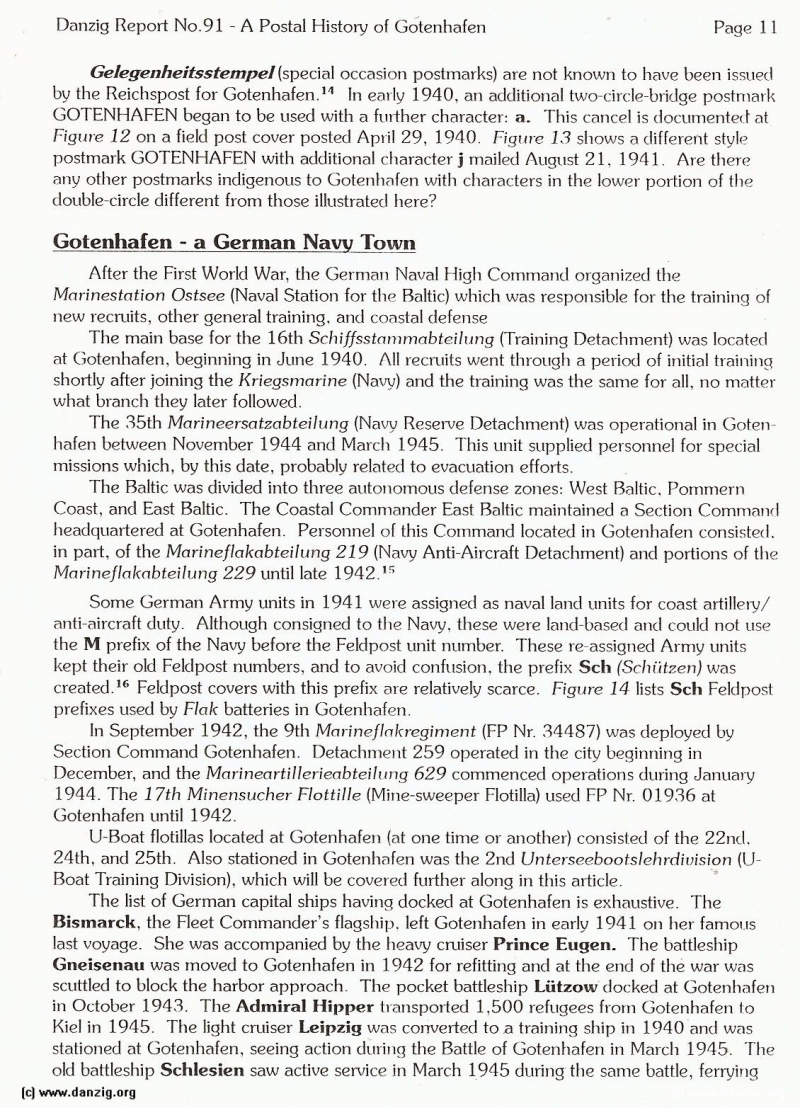
Gelegenheitsstempel (special occasion postrnarks) are not known to have been issue(l by the Reichspost for Gotenhafen.’1 In early 1940, an additional two-circle-bridge postmark GOTENHAFEN began to be used with a further character: a. This cancel is (locurnente(l at Figure 12 on a field post cover posted April 29, 1940. Figure 13 shows a different style postmark GOTENHAFEN with additional character j mailed August 21. 1941. Are there any other postrnarks indigenous to Gotenhafen with characters in the lower portion of the double-circle different from those illustrated here?
Gotenhafen - a German Navy Town
After the First World War, the German Naval I ugh Command organized the Marinestation Ostsee (Naval Station for the Baltic) which was responsible for the training of new recruits, other general training, and coastal defense.
The main base for the 16th Schiffsstammabteilunq (Training Detachment) was located at Gotenhafen, beginning in June 1940. All recruits went through a periI of initial training shortly after joining the Kriegsrnarine (Navy) and the training was the same for all, no matter what branch they later followed.
The 35th Marineersatzabteilung (Navy Reserve Detachment) was operational in Gotenh afen between November 1944 and March 1945. This unit supplied personnel for special missions which, by this date, probably related to evacuation efforts.
The Baltic was divided into three autonomous defense zones: West Baltic, Pommern Coast, and East Baltic. The Coastal Commander East Baltic maintained a Section Command headquartered at Gotenhafen. Personnel of this Command located in Gotenhafen consisted. in part, of the Marineflakabteilung 219 (Navy Anti-Aircraft Detachment) and portions of the Marinefkiknbteilung 229 until late l942.’
Some German Army units in 1941 were assigned as naval land units for coast artillety/ anti-aircraft duty. Although consigned to the Navy, these were land-based and could not use the M prefix of the Navy before the Feldpost unit number. These re-assigned Army units kept their old Feldpost numbers, and to avoid confusion, the prefix Sch (Schiitzen) was created.’6 Feldpost covers with this prefix are relatively scarce. Figure 14 lists Sdi Feldpost prefixes used by Flak batteries in Gotenhafen.
In September 1942, the 9th Marinefkikregirnent (FP Nr. 34487) was deployed bySection Command Gotenhafen. Detachnwnt 259 operated in the city beginning inDecember, and the Man nea rti llerieabtei h ing 629 commenced operations during January 1944. The 17th Minensucher Flottille (Mine-sweeper Flotilla) used FP Nr. 01936 atGotenhafen until 1942.
U-Boat flotillas located at Gotenhafeti (at one time or another) consisted of the 22nd. 24th, and 25th. Also stationed in Gotenhafen was the 2nd Unterseebootslehrdivision (U- Boat Training Division), which will be covered further along in this article.
The list of German capital ships having docked at Gotenhafen is exhaustive. The Bisinarck, the Fleet Commander’s flagship. left Gotenhafen in early 1941 on her famous last voyage. She was accompanied by the heavy cruiser Prince Eugen. The battleship Gneisenau was moved to Gotenhafen in 1942 for refitting and at the end of the war was scuttled to block the harbor approach. The pocket battleship Lützow (locked at Gotenhafen in October 1943. The Admiral Hipper transported 1,500 refugees from c;otenhafei to Kiel in 1945. The light cruiser Leipzig was converted to a training ship in 1940 and was stationed at Gotenhafen, seeing action during the Battle of Gotenhafen in March 1945. The 01(1 battleship Schiesien saw active service in March 1945 during the same battle, ferrying
Danzig Report Vol. 1 - Nr. 91 - April - May - June - 1996, Page 11.
Hits: 1736
Added: 13/07/2015
Copyright: 2024 Danzig.org

